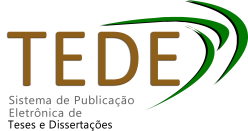| Compartilhamento |


|
Use este identificador para citar ou linkar para este item:
http://www.bdtd.ueg.br/handle/tede/1384Registro completo de metadados
| Campo DC | Valor | Idioma |
|---|---|---|
| dc.creator | Ferreira, Jannaína Soares Silva Reis | - |
| dc.creator.Lattes | http://lattes.cnpq.br/4868057752787400 | por |
| dc.contributor.advisor1 | Vieira, Marília Silva | - |
| dc.contributor.advisor1Lattes | http://lattes.cnpq.br/2253650419657216 | por |
| dc.contributor.referee1 | Vieira, Marília Silva | - |
| dc.contributor.referee2 | Kailer, Dircel Aparecida | - |
| dc.contributor.referee3 | Silva, Eduardo Batista da | - |
| dc.date.accessioned | 2024-01-25T17:35:41Z | - |
| dc.date.issued | 2023-03-02 | - |
| dc.identifier.citation | FERREIRA, Jannaína Soares Silva Reis. O apagamento da oclusiva dental /d/ em gerúndio: uma análise sociolinguística do falar vilaboense. 2023. 107 f. Dissertação (Mestrado em Língua, Literatura e Interculturalidade) – Câmpus Cora Coralina, Universidade Estadual de Goiás, Goiás, GO, 2023. | por |
| dc.identifier.uri | http://www.bdtd.ueg.br/handle/tede/1384 | - |
| dc.description.resumo | A presente pesquisa buscou descrever o apagamento da oclusiva dental /d/ em gerúndio na fala de moradores da Cidade de Goiás-GO. A pesquisa foi conduzida à luz da Sociolinguística Variacionista (LABOV 1997, LABOV 2001, LABOV, 2008[1972] e WEINREICH, LABOV E HERZOG, 2006) que tem como objetivo de estudo a mudança e variação da língua no contexto social, tais como algumas pesquisas que fundamentam esta dissertação e que descrevem o fenômeno em diferentes regiões brasileiras: Ferreira (2010), Martins e Bueno (2011), Hora e Aquino (2012), Nascimento et al (2013), Almeida e Oliveira (2017) e Vieira (2011). Ao dedicarse à comunidade linguística supracitada, este estudo procura preencher uma lacuna do fenômeno no que diz respeito ao seu mapeamento sociolinguístico. Utilizamos o corpus coletado por Bernardes (2020), que dispõe de 24 entrevistas com informantes vilaboenses, nascidos ou moradores da Cidade de Goiás desde os dois anos de idade. As entrevistas foram realizadas com roteiro semiestruturado. As ocorrências foram submetidas a tratamento acústico no PRAAT e, posteriormente, à análise estatística no RStudio, ambiente no qual verificamos os seguintes condicionadores linguísticos que influenciam o apagamento de /d/ em gerúndio: extensão do vocábulo, contexto fonético-fonológico precedente e contexto fonético-fonológico seguinte, cotejando os resultados obtidos com a análise de dados da Cidade de Goiás com aqueles de outras partes do país. Além disso, foram analisadas três variáveis sociais: faixa etária, escolaridade e sexo. Em um total de 459 ocorrências de verbos no gerúndio há uma aplicação da regra do apagamento de /d/ no morfema de gerúndio em 307 ocorrências, ou seja, 66,9% do total indicando que a forma inovadora é a mais utilizada no falar vilaboense. As análises permitiram constatar que os fatores que mais contribuem para a realização da forma inovadora são escolaridade e faixa etária, tendo em vista que os demais fatores, tanto extralinguísticos e linguísticos apresentaram pouca relevância no apagamento de /d/ em morfema de gerúndio. Constatamos que os fatores extralinguísticos são mais decisivos que os fatores linguísticos, visto que os informantes com Ensino Médio apresentam maior aplicação da regra de apagamento de /d/ em morfema de gerúndio, confirmando a hipótese de que o apagamento da oclusiva dental /d/ em (ndo) em gerúndio no falar vilaboense é condicionada pelo fator escolaridade, e que há uma relação direta entre o aumento da escolaridade e escolha pela variante conservadora. A faixa etária evidenciou que quanto maior a idade, menor a regra de aplicação do apagamento, refutando nossa hipótese de ambas as faixas etária aplicam a regra de apagamento da oclusiva dental /d/, indicando uma variação estável. | por |
| dc.description.abstract | This research sought to describe the deletion of the dental stop /d/ in the gerund in the speech of residents of the City of Goiás-GO. The research was conducted in the light of Variationist Sociolinguistics (LABOV 1997, LABOV 2001, LABOV, 2008[1972] and WEINREICH, LABOV AND HERZOG, 2006) which aims to study the change and variation of language in the social context, such as some researches that support this dissertation and that describe the phenomenon in different Brazilian regions: Ferreira (2010), Martins and Bueno (2011), Hora and Aquino (2012), Nascimento et al (2013), Almeida and Oliveira (2017) and Vieira ( 2011). By dedicating itself to the linguistic community, this study seeks to fill a gap in the phenomenon with regard to its sociolinguistic mapping. We used the corpus collected by Bernardes (2020), which has 24 interviews with informants, born or living in the City of Goiás since they were two years old. The interviews were conducted using a semi-structured script. Occurrences were submitted to acoustic treatment in PRAAT and, subsequently, to statistical analysis in RStudio, an environment in which we verified the following linguistic conditioners that influence the deletion of /d/ in gerund: word length, preceding phonetic-phonological context and phonetic context -following phonological, comparing the results obtained with the analysis of data from the City of Goiás with those from other parts of the country. In addition, three social variables were analyzed: age group, education and gender. In a total of 459 occurrences of verbs in the gerund, there is an application of the deletion rule of /d/ in the gerund morpheme in 307 occurrences, that is, 66.9% of the total, indicating that the innovative form is the most used in Vilaboense speaking. The analyzes showed that the factors that most contribute to the realization of the innovative form are schooling and age group, considering that the other factors, both extralinguistic and linguistic, showed little relevance in the deletion of /d/ in gerund morpheme. We verified that the extralinguistic factors are more decisive than the linguistic factors, since the informants with high school showed a greater application of the deletion rule of /d/ in gerund morpheme, confirming the hypothesis that the deletion of the dental stop /d/ in (ing) in gerund in Vilaboense speech is conditioned by the schooling factor, and that there is a direct relationship between the increase in schooling and the choice for the conservative variant. The age range showed that the higher the age, the lower the deletion application rule, refuting our hypothesis that both age groups apply the deletion rule of the dental stop /d/, indicating a stable variation. | eng |
| dc.description.provenance | Submitted by Marília Dias (bib.goias@ueg.br) on 2024-01-25T17:35:16Z No. of bitstreams: 2 DISSERTACAO_JANNAINA_SOARES_SILVA_REIS_FERREIRA.pdf: 2400345 bytes, checksum: 34f608ce316847b60f8c5fe03a32dde5 (MD5) license.txt: 2109 bytes, checksum: b76a28645f58b21aeda00ac459312a65 (MD5) | eng |
| dc.description.provenance | Approved for entry into archive by Marília Dias (bib.goias@ueg.br) on 2024-01-25T17:35:41Z (GMT) No. of bitstreams: 2 DISSERTACAO_JANNAINA_SOARES_SILVA_REIS_FERREIRA.pdf: 2400345 bytes, checksum: 34f608ce316847b60f8c5fe03a32dde5 (MD5) license.txt: 2109 bytes, checksum: b76a28645f58b21aeda00ac459312a65 (MD5) | eng |
| dc.description.provenance | Made available in DSpace on 2024-01-25T17:35:41Z (GMT). No. of bitstreams: 2 DISSERTACAO_JANNAINA_SOARES_SILVA_REIS_FERREIRA.pdf: 2400345 bytes, checksum: 34f608ce316847b60f8c5fe03a32dde5 (MD5) license.txt: 2109 bytes, checksum: b76a28645f58b21aeda00ac459312a65 (MD5) Previous issue date: 2023-03-02 | eng |
| dc.format | application/pdf | * |
| dc.language | por | por |
| dc.publisher | Universidade Estadual de Goiás | por |
| dc.publisher.department | UEG ::Coordenação de Mestrado em Língua, Literatura e Interculturalidade | por |
| dc.publisher.country | Brasil | por |
| dc.publisher.initials | UEG | por |
| dc.publisher.program | Programa de Pós-Graduação Strito sensu em Língua, Literatura e Interculturalidade (POSLLI) | por |
| dc.rights | Acesso Aberto | por |
| dc.subject | Sociolinguística variacionista | por |
| dc.subject | Apagamento de /d/ em gerúndio | por |
| dc.subject | Cidade de Goiás, GO | por |
| dc.subject | Variationist sociolinguistics | eng |
| dc.subject | Deletion of /d/ in gerund | eng |
| dc.subject | City of Goiás, GO | eng |
| dc.subject.cnpq | LINGUISTICA, LETRAS E ARTES::LINGUISTICA | por |
| dc.subject.cnpq | LINGUISTICA::SOCIOLINGUISTICA E DIALETOLOGIA | por |
| dc.title | O apagamento da oclusiva dental /d/ em gerúndio : uma análise sociolinguística do falar vilaboense | por |
| dc.title.alternative | The deletion of the dental occlusive /d/ in gerund : a sociolinguistic analysis of vilaboense speaking | eng |
| dc.type | Dissertação | por |
| Aparece nas coleções: | Mestrado Acadêmico em Língua, Literatura e Interculturalidade | |
Arquivos associados a este item:
| Arquivo | Descrição | Tamanho | Formato | |
|---|---|---|---|---|
| DISSERTACAO_JANNAINA_SOARES_SILVA_REIS_FERREIRA.pdf | Dissertação | 2,34 MB | Adobe PDF | Baixar/Abrir Pré-Visualizar |
Os itens no repositório estão protegidos por copyright, com todos os direitos reservados, salvo quando é indicado o contrário.




